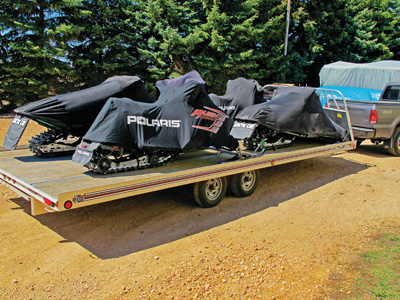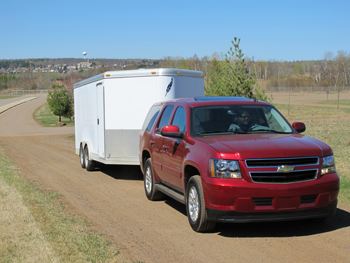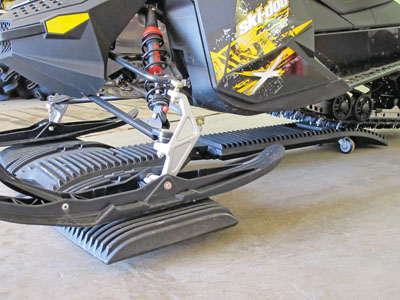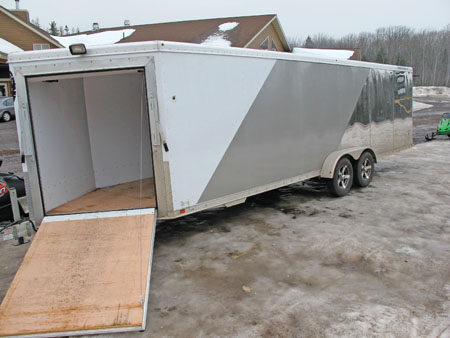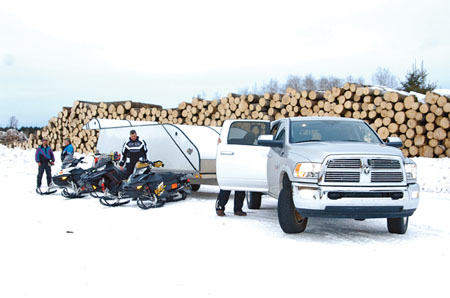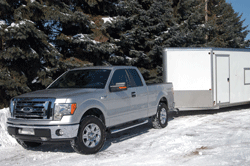Tested: Ridgeline 12-foot Cap Trailer
 There are dozens of options and configurations for snowmobile trailers. You can buy enclosed trailers, open trailers; trailers with capacity for one sled all the way up to six machines. Shopping for an enclosed trailer that catches less wind to improve tow vehicle fuel mileage? Those haulers are increasingly popular. Want to load it up with features like windows, storage solutions and bright lights inside and out? All you have to do is ask.
There are dozens of options and configurations for snowmobile trailers. You can buy enclosed trailers, open trailers; trailers with capacity for one sled all the way up to six machines. Shopping for an enclosed trailer that catches less wind to improve tow vehicle fuel mileage? Those haulers are increasingly popular. Want to load it up with features like windows, storage solutions and bright lights inside and out? All you have to do is ask.
But what if you want a simple, no-frills way to transport two snowmobiles and keep them clean and dry while doing it? We learned that Ridgeline, a new trailer company based out of central Minnesota, makes a darned nice rig to do that. We demo’d a capped, 12-foot aluminum trailer from the company last winter.
Well Built
There are a lot of standard features worth noting about Ridgeline aluminum trailers. Decking is marine-grade plywood, five-eighths of an inch thick; this is an option on other trailers. Diameter of tie-down bar cranks and the ramp retainer crank is three-quarters of an inch. Hyfax material runs along the front and rear edge of the trailer to prevent damage to the deck caused by carbides. This same material is used on the loading ramp. LED taillights scream “Stop!”
Thick, rubber weather-stripping along the bottom of the cap at the front and rear form a positive seal against road salt and slush — gear bags that we stashed on the deck between the skis was always clean and dry when we reached our destination. Two tie-down holes on each side at front and rear of the trailer offer flexibility for tie-down points.
Our trailer included an optional spare tire carrier ($250); it was essentially a boat trailer winch with the strap wrapped around the wheel assembly and hooked into the center of the rim. To use it, turn the handle and lower the wheel to the ground. It’s easy to use and puts the spare out of sight and out of the way.
Using It
The boxed, outer frame was rigid so the trailer didn’t bounce or wiggle when loading and unloading sleds. It towed straight and steady without bouncing or swaying. The tall cap on top of 13-inch wheels — attached to a rated 3,500-pound axle — caught more wind than other capped trailers we’ve used, which made our pickups and SUVs work a little harder and probably burn more fuel. We wouldn’t trade the big wheels, though, because their larger tires are more durable, especially for long runs down the freeway.
The cap is light and easy for a person to raise from the front or back to load or unload sleds. Four metal pins that secure the topper at the corners smoothly slide in and out of the hinge, but there’s friction for a snug fit so they won’t rattle and wear. The holes line up well, making the cap easy to use. Tie-down bars are simple — like they should be. Just a crank and an aluminum bar instead of an over-engineered system that some other snowmobile trailer manufacturers use.
The boxy shape isn’t as pleasing to our eyes as other caps, but the square rear end lends more space for big stuff like ATVs and motorcycles — or maybe even to haul your brother’s 60-inch tube TV all the way from the era of the Indy XLT to a recycling center. The ramp is light so one person can easily handle it, and the full-length groove along the back of the trailer lets users attach the ramp anywhere, offering flexibility to slide the ramp toward the center of the trailer for less interference with the cap’s support legs while loading.

More Bang, More Bucks
Ridgeline lists on its website dealers in Minnesota, North Dakota, Wisconsin, Saskatchewan, Manitoba and Alberta. Like most other snowmobile trailer manufacturers, there are many sizes and lengths to choose from, but comparing standard features of a Ridgeline make it stand out when compared to other trailers in the crowd. Our trailer listed for $5,400, which is about $1,000 bucks more than comparable trailers from other manufacturers, but it seems to be built to last for many years.
Evaluation:
Appearance: 1.7/2
Build Quality: 2/2
Value: 1.8/2
Towing: 1.8/2
Materials: 2/2
Total: 9.3/10
— Andy Swanson

